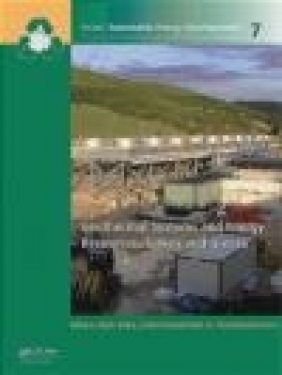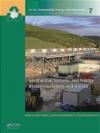Geothermal Systems and Energy Resources
Geothermal Systems and Energy Resources
- Producent: CRC Press Inc.
- Rok produkcji: 2014
- ISBN: 9781138001091
- Ilość stron: 336
- Oprawa: Twarda
Niedostępna
Opis: Geothermal Systems and Energy Resources
In the region comprising Turkey and Greece, people have been using water from geothermal sources for bathing and washing of clothes since ancient times. This region falls within the Alpine-Himalayan orogenic belt and hence is a locus of active volcanism and tectonism and experiences frequent seismic events. This volcanic and tectonic activity has given rise to over 1500 geothermal springs. Its importance was recognized decades ago and the geothermal water is now being utilized for district heating, industrial processing, domestic water supply, balneology and electric power generation. The geothermal potential in this region is large. In Turkey alone it is estimated to be more than 31500 MWt while the proven potential is 4078 MWt. At present 2084 MWt is being utilized for direct applications in Turkey and 135 MWt in Greece. In Turkey electricity is produced for 166 MW installed capacity, whereas in Greece geothermal energy is presently not used for electricity production despite its potential. This book discusses the geochemical evolution of the thermal waters and thermal gases in terms of the current volcano-tectonic setting and associated geological framework that makes the region very important to the geothermal scientific community. The book explains, in a didactic way, the possible applications, depending on local conditions and scales, and it presents new and stimulating ideas for future developments of this renewable energy source. Additionally, the book discusses the role(s) of possible physicochemical processes in deep hydrothermal systems, the volatile provenance and relative contributions of mantle and crustal components to total volatile inventories. It provides the reader with a thorough understanding of the geothermal systems of this region and identifi es the most suitable solutions for specifi c tasks and needs elsewhere in the world. It is the fi rst time that abundant information and data from this region, obtained from intensive research during the last few decades, is unveiled to the international geothermal community. Thus, an international readership, in the professional and academic sectors, as well as in key institutions that deal with geothermal energy, will benefit from the knowledge from geothermal research and experiences obtained from the Aegean Region.About the book series Editorial board Contributors Preface by Ladislaus Rybach Editors' foreword About the editors Acknowledgements 1. Chemical and isotopic constraints on the origin of thermal waters in Anatolia, Turkey: fluid-mineral equilibria approach Halim Mutlu, Nilgun Gulec & David R. Hilton 1.1 Introduction 1.2 Geological setting 1.3 Water chemistry 1.4 Geothermometry applications 1.4.1 Chemical geothermometers 1.4.2 Na-K-Mg diagram 1.5 Stable isotopes 1.5.1 delta18O-deltaD compositions 1.5.2 delta34S-delta13C compositions 1.6 Mineral equilibrium calculations 2. Gas geochemistry of Turkish geothermal fluids: He-CO2 systematics in relation to active tectonics and volcanism Nilgun Gulec, Halim Mutlu & David R. Hilton 2.1 Introduction 2.2 Framework of tectonic, volcanic, and geothermal activities 2.3 He-CO2 systematics 2.4 Discussion 2.4.1 Physicochemical processes in hydrothermal systems 2.4.2 Volatile provenance: relative contributions of mantle and crustal components 2.4.3 Spatial distribution of mantle volatiles: relation to tectonic and volcanic activities 2.5 Conclusions 3. Geothermal fields and thermal waters of Greece: an overview Nicolaos Lambrakis, Konstantina Katsanou & George Siavalas 3.1 Prologue-historical background 3.2 Introduction 3.3 The paleogeographical setting of Greece 3.4 Volcanism of Greece 3.5 The distribution of heat flow and cause of geothermal anomalies in Greece 3.5.1 Back-arc regions 3.5.2 Volcanic arc of the South Aegean Sea 3.5.3 Western Greece 3.6 Geological setting of the major geothermal fields 3.6.1 Back-arc geothermal fields of Greece 3.6.2 Volcanic arc of South Aegean Sea 3.6.3 Low-enthalpy geothermal fields of western Greece 3.7 Chemical composition of thermal and mineral waters 3.7.1 Materials and methods 3.7.2 Hydrochemistry of geothermal fields 3.7.2.1 Hydrochemistry of back-arc geothermal fields 3.7.2.2 Hydrochemistry of Aegean volcanic arc geothermal fields 3.7.2.3 Hydrochemistry of geothermal fields from western Greece 3.7.2.4 Minor and trace elements of Greek thermal waters 3.8 Conclusions 4. Geological setting, geothermal conditions and hydrochemistry of south and southeastern Aegean geothermal systems Maria Papachristou, Konstantinos Voudouris, Stylianos Karakatsanis, Walter D'Alessandro & Konstantinos Kyriakopoulos 4.1 Introduction 4.2 General geological setting 4.2.1 South Aegean Active Volcanic Arc 4.3 Regional geological and geothermal setting 4.3.1 Milos 4.3.2 Kimolos 4.3.3 Santorini 4.3.4 Nisyros 4.3.5 Kos 4.3.6 Ikaria Island 4.3.7 Chios Island 4.4 Sampling and data analysis 4.5 Results 4.5.1 Major elements composition 4.5.2 Hydrochemistry and water types 4.5.2.1 Milos Island 4.5.2.2 Kimolos Island 4.5.2.3 Santorini Island 4.5.2.4 Nisyros Island 4.5.2.5 Kos Island 4.5.2.6 Ikaria Island 4.5.2.7 Chios Island 4.5.3 Trace elements composition 4.6 Statistical analysis 4.6.1 Cluster analysis 4.6.2 Factor analysis 4.7 Discussion and conclusion 5. Application of hydrogeochemical techniques in geothermal systems; examples from the eastern Mediterranean region Aysen Davraz 5.1 Introduction 5.2 Hydrogeochemical evaluation of geothermal fluids 5.2.1 Collection of samples 5.2.2 In situ measurements 5.2.3 Chemical analyses 5.2.4 Data interpretation 5.2.4.1 Case studies in the eastern Mediterranean region 5.3 Processes affecting geothermal fluid composition 5.3.1 The saturation indices of geothermal waters in the eastern Mediterranean region 5.4 Geothermometry 5.4.1 Chemical geothermometers 5.4.1.1 Silica geothermometry 5.4.1.2 Cation geothermometry 5.4.2 Isotope geothermometers 5.4.2.1 Oxygen isotope geothermometry 5.4.3 Gas geothermometers 5.4.4 Geothermometer applications in the eastern Mediterranean region 5.5 Stable isotope applications 5.5.1 Results from the stable isotope analysis in the eastern Mediterranean region 5.6 Conclusions 6. Hydrochemical investigations of thermal and mineral waters in the Turgutlu-Salihli-Ala,sehir plain (Gediz graben), western Turkey Tugbanur Ozen & Gultekin Tarcan 6.1 Introduction 6.2 Geological and hydrogeological settings 6.3 General information of the geothermal areas 6.4 Hydrochemical settings 6.4.1 Geothermometry applications 6.4.1.1 Chemical geothermometers 6.4.1.2 The ternary (Na-K-Mg) diagram 6.4.2 Mineral saturation 6.5 Conclusions 7. Electrically conductive structures and geothermal model in Sakarya-Goynuk area in eastern Marmara region inferred from magnetotelluric data Ilyas Caglar 7.1 Introduction 7.2 Near-surface and deep electrical structure 7.3 Geoelectric structure and geothermal model 7.4 Conclusion 8. Use of sulfur isotopes on low-enthalpy geothermal systems in Aya,s-Beypazari (Ankara), central Anatolia, Turkey Mehmet Celik 8.1 Introduction 8.2 Geology and hydrogeology 8.3 Hydrochemical and isotopic studies 8.3.1 Hydrochemical and isotopic evaluation 8.3.2 Sulfur isotope evaluation 8.4 Results 9. Geochemistry of thermal waters in eastern Anatolia: a case study from Diyadin (Agri) and Ercis-Zilan (Van) Suzan Pasvanoglu 9.1 Introduction 9.2 Site description 9.2.1 Diyadin (Agri) area 9.2.2 Zilan (Van-Ercis) area 9.3 Field survey-methodology-analysis 9.4 Geological setting 9.4.1 Geology of Diyadin geothermal field 9.4.2 Geology of Zilan geothermal field 9.5 Hydrgeology 9.5.1 Diyadin (Agri) geothermal field 9.5.2 Zilan (Ercis) geothermal field 9.6 Results and discussion 9.6.1 Water chemistry 159 9.6.2 Trace element contents of Diyadin waters 9.6.3 Geothermometers 9.6.4 Isotopic composition of waters 9.7 Conclusion 10. Balcova geothermal field district heating system: lessons learned from 16 years of application Mahmut Parlaktuna 10.1 Geographical setting, geology, and geochemistry of the field 10.2 Development of the field 10.3 Utilization of the field 10.4 Lessons learned 10.4.1 Pipeline network 10.4.2 Decline in reservoir pressure 10.4.3 Pricing policy 10.5 Current status of the field 11. Rapid development of geothermal power generation in Turkey Murat Karadas & Gulden Gokcen Akkurt 11.1 Introduction 11.2 Present status of geothermal power plants in Turkey (2013) 11.3 Characteristics of geothermal resources in Aegean region 1 11.4 Types of geothermal power plants for reservoir characteristics of Aegean region 11.4.1 Single and double flash geothermal power plants 11.4.2 Binary cycle geothermal power plants 11.5 Geothermal power plants in Turkey 11.5.1 Kizildere geothermal power plant 11.5.1.1 Brief historical development of Denizli-Kizildere geothermal field 11.5.1.2 Power generation 11.5.1.3 Scaling problems in Kizildere geothermal power plant 11.5.1.4 Future of Denizli-Kizildere geothermal field 11.5.2 Dora geothermal power plants 11.5.2.1 Brief historical development of Salavatli geothermal field 11.5.2.2 Dora-1 geothermal power plant 11.5.2.3 Power generation 11.5.2.4 Performance assessment of the plant 11.5.3 Germencik double flash geothermal power plant 11.5.3.1 Brief historical development of Germencik-Omerbeyli geothermal field 11.5.3.2 Power generation of the plant 11.5.4 Tuzla geothermal power plant 11.5.4.1 Brief historical development of tuzla geothermal field 11.5.4.2 Power generation and performance assessment of the plant 11.5.4.3 Scaling problems of the plant 11.5.5 Other geothermal power plants 11.5.5.1 Bereket geothermal power plant 11.5.5.2 Dora-2 geothermal power plant 11.5.5.3 Irem geothermal power plant 11.6 Conclusion 12. Scaling problem of the geothermal system in Turkey Irmak Dogan, Mustafa M. Demir & Alper Baba 12.1 Introduction 12.2 Geothermal energy in Turkey 12.3 Scaling in geothermal system of Turkey 12.4 Conclusion 13. Exergetic and exergoeconomic aspects of ground-source (geothermal) heat pumps in Turkey Arif Hepbasli & Ebru Hancioglu Kuzgunkaya 13.1 Introduction 13.2 Energetic, exergetic, and exergoeconomic relations 13.2.1 Mass, energy, entropy, and exergy balances 13.2.2 Energy and exergy efficiencies 13.2.3 Exergetic improvement potential 13.2.4 Some thermodynamic parameters 13.2.5 Exergoeconomic analysis relations 13.3 Exergetically and exegoeconomically analyzed GSHPS 13.3.1 Exergetically analyzed GSHP systems 13.3.2 Greenhouses 13.3.3 Drying 13.3.4 Exergoeconomically analyzed GSHP systems 13.4 Concluding remarks 14. Application of geophysical methods in Gulbahce geothermal site, Urla-Izmir, western Anatolia Oya Pamukcu, Tolga Gonenc, Petek Sindirgi & Alper Baba 14.1 Introduction 14.2 Geology and tectonic properties of study area 14.3 Geophysical studies 14.3.1 Gravity and magnetic 14.3.2 Self-potential 14.3.3 Vertical electrical sounding method 14.4 Result and conclusion 15. Palaeoenvironmental and palynological study of the geothermal area in the Gulbahce Bay (Aegean Sea, western Turkey) Mine Sezgul Kayseri-Ozer, Bade Pekcetinoz & Erdeniz Ozel 15.1 Introduction 15.2 Geological setting and high-resolution shallow seismic study (3.5 khz) 15.3 Important plants and nonpollen palynomorphs of quaternary in Gulbahce Bay 15.3.1 Pollen 15.3.2 Nonpollens 15.4 Corals in Gulbahce Bay 15.5 Palynology 15.5.1 Reference zone 15.5.2 Defining palynomorphs of thermal spring locations from Gulbahce Bay 15.6 Palaeo environment 15.6.1 Terrestrial condition in the Gulbahce Bay 15.6.2 Marine condition in the Gulbahce Bay Subject index Book series page
Szczegóły: Geothermal Systems and Energy Resources
Tytuł: Geothermal Systems and Energy Resources
Producent: CRC Press Inc.
ISBN: 9781138001091
Rok produkcji: 2014
Ilość stron: 336
Oprawa: Twarda
Waga: 0.84 kg



















